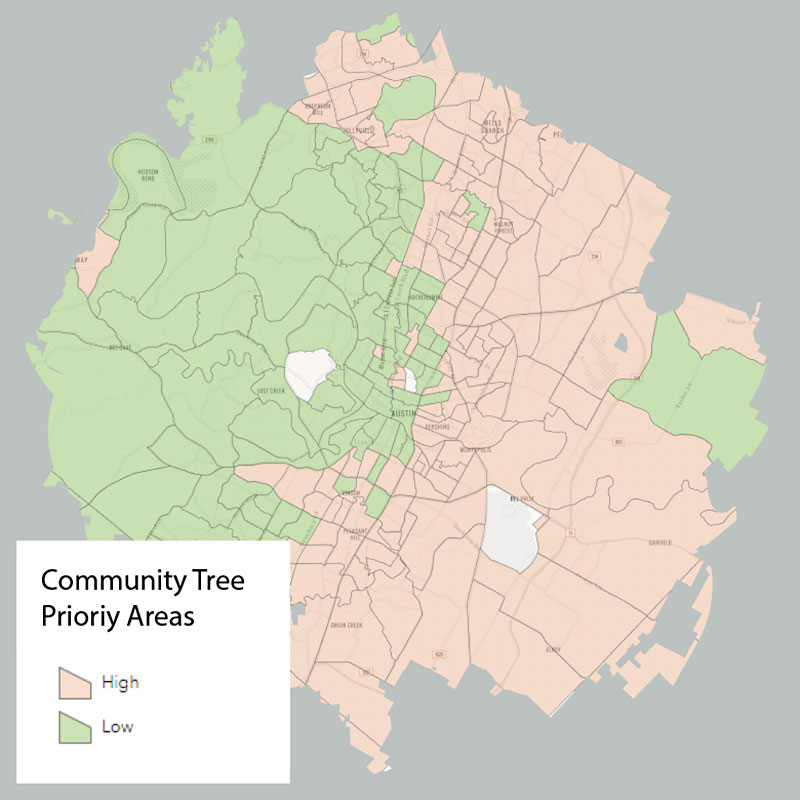Austin’s trees contribute more than $38 million in savings including energy costs and avoided health care expenses, but the shade and its benefits aren’t distributed evenly (photo by Zeke Barbaro)
Austinites have been facing a record-hot summer, having just endured the hottest May, June, and July on record. August is on track to join those ranks, with an average temperature of 90.5 degrees Fahrenheit as of Wednesday. (That means the average of both daytime and nighttime temps.) Streaks of triple-digit-degree days have spurred heat advisories, along with increased risk of wildfire and drought.
Many of us can take advantage of air conditioning or the cooling effects of the city’s pools and springs. But the city’s urban forest also provides major relief from the heat. “Trees absolutely cool the air around them and they provide shade, which also helps cool paved surfaces that tend to store and radiate heat,” Emily King, the urban forester for the city of Austin, told the Chronicle.
A good thing, then, that Austin is home to over 33 million trees, which shade over 35% of the city, according to the city’s Community Tree Report. It notes that Austin’s trees contribute more than $38 million in savings for Austinites every year, including reduced energy costs, carbon sequestration, pollution removal, and avoided health care costs.
But not all trees are distributed equally. A 2021 report by the nonprofit American Forests found Austin’s high-income and low-income neighborhoods have a 20% disparity in canopy coverage – that’s the widest gap in the country. (Canopy coverage means having not only more trees but larger and older trees.) “It is not an accident that we see huge discrepancies in the urban tree canopy between the predominantly white west side and predominantly Black and Latinx Eastside,” said Dr. Deidre Zoll, a postdoc fellow of integrative biology at UT-Austin. “The shortest answer is racism.”
A map from the city shows that the areas in most need of shade trees, and all the benefits that come with them, are on the Eastside (Courtesy of city of Austin)
Alexia Leclercq of longtime Eastside environmental justice advocacy group People Organized in Defense of Earth and her Resources (PODER) agrees. “In addition to bearing the brunt of pollution and exposure to toxic chemicals, there is less green spaces, less tree coverage, and overall less environmental protection and regulation [in East Austin],” she said. “This leads to discrepancies in the well-being of people living in the area; we know increase in canopy [coverage] is correlated with cooler weather and cleaner air.”
Carmen Llanes Pulido, executive director of Go Austin/Vamos Austin (GAVA), works among Austin’s Eastern Crescent communities and shared how folks have been dealing with the heat. “People just talk about having to cope with keeping their kids inside a lot of the day, which is rough,” she said. “For people who live closer to greenbelts in some of our neighborhoods, it’s such a massive difference. The difference of being in a greenbelt area at 4 or 5pm versus on concrete is night and day.”
“It is not an accident that we see huge discrepancies in the urban tree canopy between the predominantly white west side and predominantly Black and Latinx Eastside.” – UT-Austin’s Dr. Deidre Zoll
Urban forests reduce air pollution and flooding while providing shade, cooler temperatures, and space for recreation. This improves things for their neighbors, like rates of asthma and cardiovascular disease, the risk of heat stroke, the cost of air conditioning, the damage caused by flooding, and overall mental health, Zoll added. “One of the starkest differences is that we can see up to a 17-year difference in life expectancy between two census tracts in East and West Austin,” she said. “If there are already inequalities in terms of cardiovascular health, more extreme heat events will likely increase the disparities [in] hospitalization, severe illnesses, and mortality.”
Pulido, an Austin native, has dealt with many long, hot summers. But the heat has gotten much more extreme in recent years, taking a toll on residents’ health, she said. “One of our folks in South Austin is a paramedic and EMT for children and talks about how many more children come in with respiratory issues in the emergency room on hot days,” she said. “When you’re seeing kid after kid after kid, you start thinking about the true cost of pulling up a bunch of heritage or keystone trees or paving over a bunch of green space.”
Since 2019, the city has been releasing an annual Community Tree Report – a one-stop source to find out about tree stewardship in Austin, King says. This year’s update shows that the city facilitated more than $1.5 million in urban-forest investment in Austin. Over 10,000 new trees were planted throughout the city, with 64% going to “high priority areas.” As you can see on the map at right, high-priority areas are almost entirely east of I-35.
Increased tree planting is encouraging, but still just a drop in the bucket for what needs to be planted to maintain Austin’s canopy, King said. “We still lose a ton of trees to natural causes, to drought, [and] to development, and climate impacts are going to be huge to the canopy,” she said. “I don’t know how we really get to a place where we can even be at a known net loss. So that’s a huge challenge.”
Pulido says the “Land Development Code wars” are putting Austin’s trees at stake. “Trees are an asset in this city, but they also stand in the way of development,” she said. “As somebody with lived experience and empirical experience in Austin … I know that trees are what make this place livable,” she said. “And I don’t want to be in an Austin without them.”
Got something to say? The Chronicle welcomes opinion pieces on any topic from the community. Submit yours now at austinchronicle.com/opinion.

